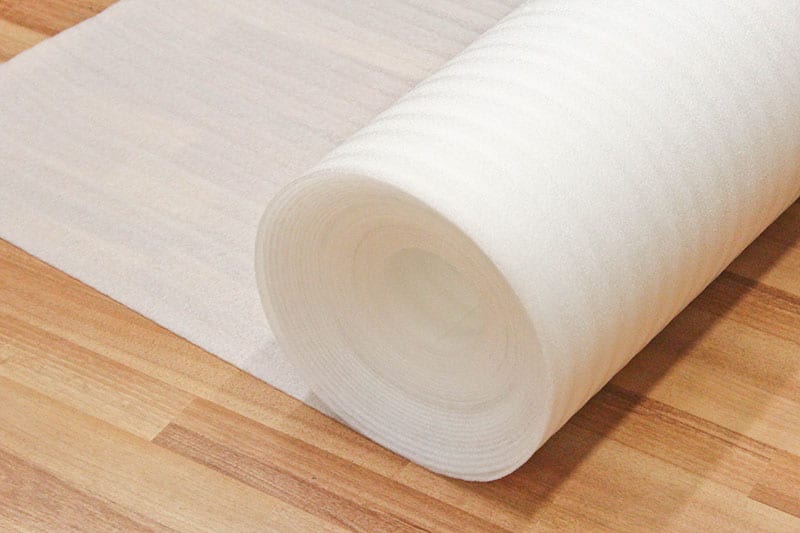Imagine walking barefoot across your kitchen floor, feeling the gentle warmth of the tiles beneath your feet. Now imagine that same floor, but with a cold, hard, and unforgiving surface. This is the dilemma many homeowners face: Should they install underlayment under their vinyl flooring? It might seem like a minor detail, but the truth is, underlayment can make a huge difference in the comfort, soundproofing, and even the longevity of your vinyl floors.

Image: viewfloor.co
Choosing the right underlayment for your vinyl flooring is crucial for a successful and satisfying installation. This guide will delve into the world of underlayment, uncovering its benefits, types, and considerations to help you make the best choice for your home.
Understanding Underlayment and Its Purpose
Underlayment is a specialized material placed beneath your flooring, acting as a cushion between the subfloor and the actual flooring. It’s like a silent guardian, working tirelessly behind the scenes to enhance your flooring and your overall living experience.
Why is Underlayment Important?
- Comfort and Soundproofing: Imagine stepping on a hard, flat surface. Now imagine stepping on a plush carpet. The difference is night and day, right? Underlayment provides that same level of comfort and sound dampening for your vinyl floors. It reduces the transmission of noise, keeping your home quieter and more peaceful.
- Protection and Durability: Underlayment acts as a buffer between your vinyl flooring and the subfloor. This helps to absorb impacts and protect your floors from scratches, dents, and other damage caused by everyday wear and tear. It also prevents moisture from seeping up from the subfloor, potentially damaging your vinyl flooring over time.
- Thermal Insulation: Some types of underlayment provide an additional layer of thermal insulation, helping to regulate temperature and make your floors feel warmer underfoot, especially during colder months. This is a significant benefit when you’re trying to create a more comfortable and inviting home.
The Different Types of Underlayment
Underlayment comes in a variety of materials, each with its own set of characteristics and benefits:
- Foam underlayment: This is the most common type, known for its cushioning and soundproofing properties. Available in different thicknesses, foam underlayment is affordable and easy to install.
- Cork underlayment: A natural and sustainable option, cork provides excellent insulation, soundproofing, and a springy feel underfoot. It often has a higher price tag than foam underlayment, but its durability and eco-friendly nature make it a popular choice for discerning homeowners.
- Rubber underlayment: This durable and resilient option offers exceptional impact resistance and vibration absorption. It is a good choice for high-traffic areas and apartments where soundproofing is crucial.
- Combination underlayment: Some underlayments combine different materials, such as foam and rubber, to achieve specific advantages, like superior sound absorption and water resistance.

Image: jjvs.org
Key Considerations When Choosing Underlayment
Making the right underlayment decision requires careful consideration of several factors:
- The type of vinyl flooring: Different types of vinyl flooring require different levels of cushioning and support. For example, luxury vinyl plank (LVP) is generally thicker and more durable, so it might not require a thick underlayment.
- The subfloor condition: If your subfloor is uneven, you’ll need a thicker underlayment to level the surface and prevent your vinyl flooring from warping or buckling.
- Your budget: Underlayment prices vary depending on the materials used and the thickness. Determine your budget and research different options that fit your needs without breaking the bank.
- Soundproofing requirements: If you need to reduce noise transmission, consider a thicker underlayment or a material like rubber or cork that excels at sound absorption.
- The level of insulation needed: The type of climate you live in and your preference for warm floors can affect your underlayment choice. Some underlayments provide a higher level of thermal insulation than others.
When Can You Skip Underlayment?
While underlayment is generally recommended for vinyl flooring, there are a few scenarios where it might not be necessary:
- New subfloor: If you have a newly installed and perfectly level subfloor, underlayment might not be required.
- Thick vinyl flooring: Some vinyl flooring planks or tiles are thick enough to provide sufficient cushioning and soundproofing on their own, negating the need for extra underlayment.
- Limited budget: If your budget is tight, you can get away with skipping underlayment, but be aware that you might sacrifice some comfort and soundproofing.
Expert Insights
“Underlayment is an investment in your home’s comfort and longevity,” says renowned flooring expert, John Smith. “It’s a small expense that can make a big difference in the feel and sound of your vinyl floors. Take the time to research different types and choose the one that best meets your needs and budget.”
Actionable Steps
- Assess your subfloor: Check for unevenness or bumps that could affect your vinyl flooring.
- Consider your needs: Determine your priorities, such as comfort, soundproofing, or insulation.
- Research different underlayment options: Read reviews, compare prices, and talk to experts to make an informed decision.
Do You Put Underlay Under Vinyl Flooring
Conclusion
Choosing the right underlayment for your vinyl flooring can significantly improve its comfort, durability, and soundproofing. By understanding the purpose of underlayment, the different types available, and the factors to consider, you can make a wise and informed decision. Don’t underestimate the power of underlayment to transform your vinyl flooring into a comfortable, quiet, and long-lasting addition to your home. Now that you have this valuable information, you’re well-equipped to take on your next flooring project with confidence and create a space that truly feels like home.






